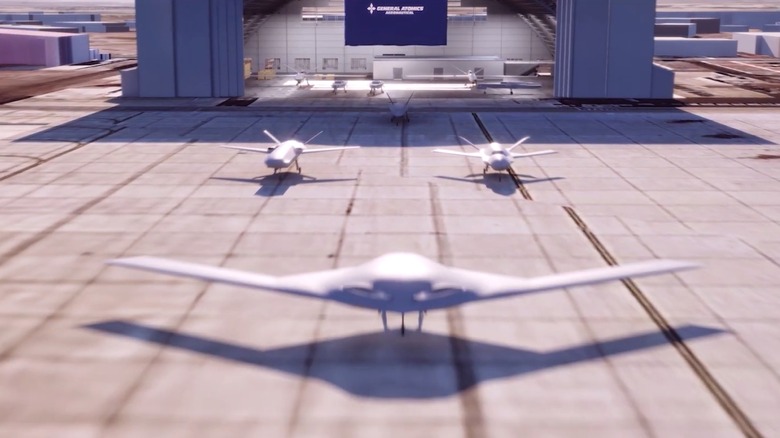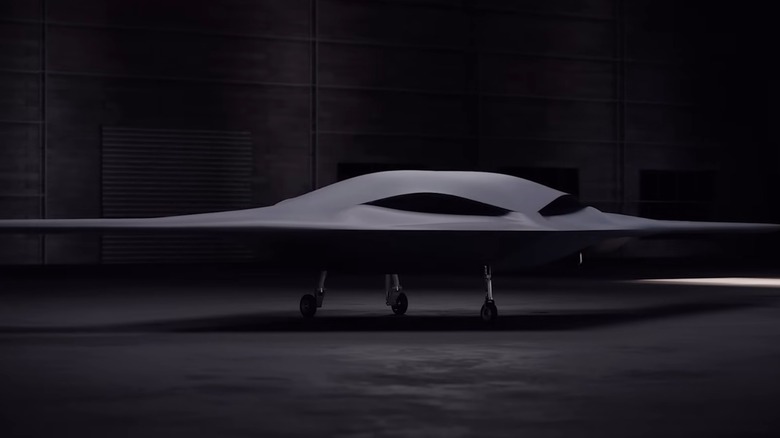Here's What We Know About The Replacement For The Reaper: The MQ-Next
General Atomics Aeronautical Systems has long been the go-to for the U.S. Air Force's Unmanned Aerial Systems (UAS). Most notably, General Atomics is responsible for the creation of the MQ-1 Predator, MQ-9 Reaper, and much more. The Reaper replaced the Predator in 2018, and the company is hard at work developing a replacement for the Reaper. The program is referred to as MQ-Next, but there are more than a few designs competing to fill the USAF's UAS requirements.
The Reaper is a hunter-killer drone that set many standards General Atomics seeks to build upon, so the MQ-Next will likely combine speed, lethality, and stealth to its next Medium Altitude Long Endurance (MALE) UAS. Prior MALE systems provided excellent overwatch during combat operations, but their vulnerabilities to anti-aircraft defenses have driven General Atomics to embrace stealth in its next generation of MALE aircraft. Should the designs currently in development go into production, the MQ-Next will replace the Reaper between 2030 and 2035.
Until that happens, the Reaper continues to dominate the skies with its latest-generation model, the MQ-9B Sky/SeaGuardian. General Atomics unveiled plans for the MQ-Next program at the 2022 Air Force Association conference. The next generation of MALE from General Atomics will likely be a stealth flying wing design, and any attached weapon systems will be integrated or kept within the hold to maintain stealth integrity. Additionally, the MQ-Next will use a hybrid electric propulsion system, which could enable the aircraft to fly for 60 hours. Since the reveal in 2022, little detail has leaked, likely to maintain secrecy, but there's still some information suggesting the MQ-Next will be a truly impressive UAS.
The MQ-Next
General Atomics is developing its next generation of UASs for the USAF by embracing automation. In 2020, a company spokesman said, "This includes automatic take-off, landing, and remote taxi, and a portable aircraft control system for aircraft launch and recovery that eliminates the need for forward-deployed launch/recovery crews." Additional improvements include upgrades to the existing Ground Control Station (GCS) used by the Reaper. These enable a single pilot to control up to six Reapers, and that technology will likely transfer to the new program.
In its announcement in 2022, General Atomics made it clear that it was taking a new approach to the MQ-Next's design. The company is working hard to perfect the flying-wing shape used by the B-2 Spirit and B-21 Raider stealth bombers. Most notably, the company is moving toward hybrid electric propulsion, which is an entirely new means of moving air-breathing aircraft through the sky. This new engine design is a game changer, as it would make it possible for the MQ-Next to fly for four times longer than the Reaper.
Other design improvements would make it possible for the MQ-Next to take off from a 3,000-foot runway and will likely not need in-flight refueling. General Atomics is also developing another new program called Gambit. This is a modular system that enables four designs from a single airframe base. If the USAF approves both projects, the MQ-Next will work in conjunction with the Gambit system to relay targeting and time-sensitive information to nearby manned aircraft.
Gambit
The Gambit System aims to answer any and all requirements for the USAF's UAS needs in an all-in-one modular design. The four variants are designed to conduct different missions. These include intelligence, surveillance, and reconnaissance (ISR); another would be armed with air-to-air weapons; the third design takes on an adversary air role, while the fourth model will function as a stealth and long-endurance aircraft. The cost of these models should be less than the cost of a Reaper.
One thing that went into the design of the Gambit system and the MQ-Next is attrition. The USAF wants aircraft it can endure losing, so cost is a consideration. Additionally, the USAF wants platforms that last for years instead of decades. Ideally, these new aircraft would require little upkeep with no depot maintenance and almost no field maintenance. These new requirements are in line with the Air Force Research Laboratory's objectives in the development of the next generation of UAS.
The Gambit will function as an Off-Board Sensing Station (OBSS), utilizing as much automation as possible. Gambit aircraft would fly beyond the line of sight of current fifth-generation fighter jets to relay targeting data. Gambit could also send this information to unmanned aircraft like the MQ-Next, so the programs are being designed with that goal in mind. General Atomics is gearing up for production of the MQ-Next and Gambit, which is further along in the design process than the MQ-Next, which will likely be properly named once it's finally unveiled.


